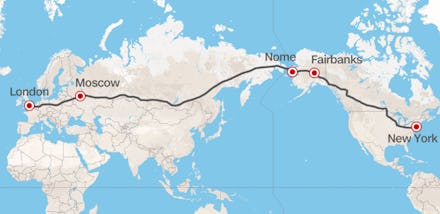Russia Just Proposed a Superhighway that Would Connect New York and London

International travel may have just gotten easier, thanks to one man's bold vision to let eager travelers get from New York to London by car.
Vladimir Yakunin, who is president of Russian Railways, has a vision, which he released last week, of a highway that would cost "trillions of dollars" and span an estimated 12,910 miles, according to CNN. In other words, get ready for the longest road trip of your life.
Digital Trends reports the Trans-Eurasian Belt Development would include a bridge that spans "over 55 miles of Bering Sea." It would connect Alaska with Russia, and run, in parts, parallel to the Trans-Siberian Railway.
Below is a concept for such a bridge, as imagined by an architect in 2013.
This would be a record-breaking international effort. While constructing the superhighway would be technically feasible, if difficult, the politics involved could pose a unique set of difficulties. Simply coordinating building efforts across countries and continents would be a challenge given that international conflict is not in short supply.
Because the project is likely to cost in the trillions — rather than in the billions like some other large infrastructure projects — organizing funding for the project will likely lead to some international bickering, especially considering Russia, which would house the bulk of the road, isn't in the best position financially.
A report by PricewaterhouseCoopers explains that "According to the World Economic Forum's Russia Competitiveness Report 2011, the cost of building a road in Moscow is $31 million versus $3.6 million in the U.S. and $1.3 million in China."
Plus, before contemplating such a monumental project, Russia needs to consider the health of its already-existing roads, some of which are "of dismal quality, especially in the east of the country," the Daily Mail reports.
Reimagining infrastructure. While challenges abound for the Russian superhighway, the notion of applying modern technology to age-old urban issues of city layouts and urban planning is catching on and finding success around the rest of the world.
In just one small example, Sweden has installed phototherapy lights in their bus stops to counteract the protracted periods of darkness in the winter, thereby tackling the real problem of seasonal affective disorder by incorporating light therapy into public services.
On a larger scale, the construction of the long-awaited Hyperloop, which will use tubes and air pressure to propel people around above ground from the Los Angeles region to the San Francisco Bay area, will begin in 2016.
Self-driving cars have also entered the lexicon of futuristic transportation. Examples of their success have already been demonstrated by companies like Google and Delphi Automotive, which recently sent an unmanned car on a cross-country road trip.
While Russia's proposal may be characteristically, well, out of the box, the concept arguably has many merits. Global collaboration on a project of this scale presents an opportunity to improve transnational communication and diplomatic ties. Connectedness, as we have seen, generally brings us closer together.